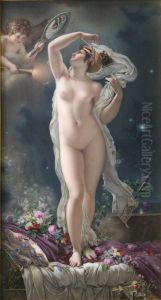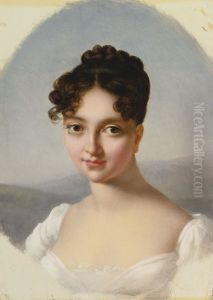Marie-Victoire Jaquotot Paintings
Marie-Victoire Jaquotot was a prominent French porcelain painter whose talent and contributions left a lasting mark on the world of fine arts during the late 18th and early 19th centuries. Born in Paris in 1772, Jaquotot was introduced to the art world at a young age. Despite the limitations placed on women in the arts during this period, she managed to establish a successful career, showcasing her exceptional skills and innovative techniques in porcelain painting, a field that was gaining popularity in Europe at the time.
Jaquotot received her training under the guidance of esteemed artists and quickly became known for her detailed and vibrant works. She was particularly celebrated for her ability to replicate famous paintings on porcelain, a meticulous and challenging process that required precision and creativity. Her work caught the attention of the French court, and she eventually became a painter to Queen Hortense de Beauharnais and later to King Louis XVIII. This royal patronage helped solidify her reputation and provided her with opportunities to work on significant projects, including the restoration and decoration of prestigious collections.
Throughout her career, Marie-Victoire Jaquotot was dedicated to perfecting her craft and expanding the possibilities of porcelain art. She was known for her portraits, landscapes, and scenes from mythology, all of which demonstrated her mastery of color and detail. In addition to her work on porcelain, Jaquotot also contributed to the education of young artists by teaching, thus ensuring the continuation of her techniques and the promotion of porcelain painting as a respected art form.
Jaquotot's legacy is preserved in various collections and museums, where her pieces are admired for their beauty and technical excellence. She continued to work and inspire others until her death in 1855, leaving behind a body of work that remains influential in the history of decorative arts. Marie-Victoire Jaquotot's life and career exemplify the challenges and triumphs of female artists in the 18th and 19th centuries, and her achievements continue to be celebrated for their impact on the arts and society.


